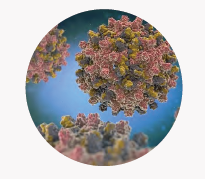We are committed to easing the burden faced by the many millions of people living with chronic hepatitis B
An estimated 14 million people live with hepatitis B in the World Health Organization European Region, resulting in about 43,000 deaths each year.[1] Most people only discover they have hepatitis B after developing advanced disease.[1]
Current treatments for chronic hepatitis B (CHB) infection interfere with viral replication and can slow the progression to cirrhosis, reduce the incidence of liver cancer and improve long-term survival, but most patients must stay on daily therapy for the rest of their lives and their levels of hepatitis B surface antigen (HBsAg) remain elevated.[2]
Our goal is to find a functional cure* for CHB after a finite period of treatment.[3] In addition to avoidance of lifelong management, which is challenging for patients in the long term, a functional cure could help them avoid the stigma often associated with CHB. We are committed to creating a future where CHB will be a thing of the past.[2]

Structure of hepatitis B
Worldwide, hepatitis B causes approximately one death every 30 seconds, mostly from complications, such as cirrhosis and hepatocellular carcinoma.[4]
Stigma is a major barrier to successful prevention, diagnosis and treatment for hepatitis B, but this is often unrecognised and unaddressed.[5]It is essential to our research to address feelings of exclusion, isolation and blame as they can impact patients’ treatment decisions and adherence.
*N.B. A functional cure for chronic hepatitis B is defined as sustained, loss of hepatitis B surface antigen (HBsAg) with or without seroconversion to hepatitis B surface antibody.[3]
Follow Us
CP-187341


